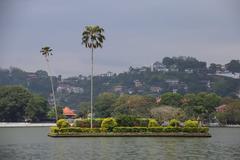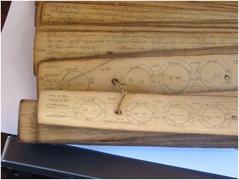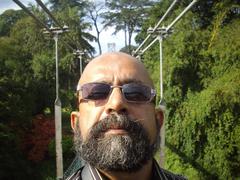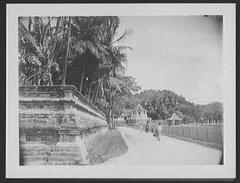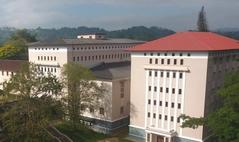
Malwathu Maha Viharaya: Visiting Hours, Tickets, and Historical Significance in Kandy
Date: 04/07/2025
Introduction
Malwathu Maha Viharaya, also known as Malwatta Maha Viharaya, is one of Sri Lanka’s most significant Buddhist monastic complexes, situated on the tranquil banks of Kandy Lake. As the principal seat of the Malwatta Chapter of the Siyam Nikaya—the island’s largest Buddhist order—this temple is not only central to Sri Lanka’s religious life but also to its national identity, heritage conservation, and community engagement. This guide details the history, architectural highlights, visiting hours, ticketing, and community aspects of Malwathu Maha Viharaya, providing everything a visitor needs to know for a meaningful experience in Kandy.
Table of Contents
- Introduction
- Historical Background and Monastic Authority
- Visiting Malwathu Maha Viharaya
- Educational, Social, and Community Engagement
- Modern Challenges and Preservation
- Relationship with the Temple of the Sacred Tooth Relic
- Frequently Asked Questions (FAQ)
- Conclusion
- Sources
Historical Background and Monastic Authority
Origins and Foundation
Malwathu Maha Viharaya traces its origins to the 15th century CE, during the reign of King Senasammata Vikramabahu, founder of the Kingdom of Kandy (Department of Archaeology, Sri Lanka). Initially established as a haven for monks fleeing persecution in the low country, the temple quickly became a central hub for consolidating Theravāda Buddhism in the highlands. Its proximity to the royal palace and the later-constructed Kandy Lake enhanced its influence and prestige (Central Cultural Fund).
Role in Sri Lankan Buddhism
As the headquarters of the Malwatta Chapter of the Siyam Nikaya (founded in 1753), Malwathu Maha Viharaya plays a leading role in preserving Buddhist tradition and overseeing religious affairs in Sri Lanka (Buddhistdoor Global). Together with the Asgiriya Chapter, it is entrusted with the custodianship of the Temple of the Sacred Tooth Relic (Sri Dalada Maligawa), home to Sri Lankan Buddhism’s most revered relic: the Buddha’s left canine tooth (UNESCO World Heritage Centre).
The temple’s Mahanayaka Thero (chief prelate) is one of the two highest-ranking Buddhist monks in Sri Lanka, wielding considerable authority over national religious matters, state ceremonies, and interfaith dialogue. The Viharaya is also a center for higher ordination (Upasampada), monastic scholarship, and the preservation of the Vinaya (monastic code).
Architectural and Artistic Heritage
Malwathu Maha Viharaya is a showcase of classic Kandyan Buddhist architecture. Key features include:
- Uposathagaraya (Chapter House): The main assembly hall for monastic rituals and higher ordinations, notable for its robust wooden pillars and traditional Kandyan roof.
- Main Shrine Room (Viharaya): Houses a large seated Buddha statue surrounded by vibrant frescoes and wood carvings.
- Library (Pirivena): Contains ancient palm-leaf manuscripts and sacred texts.
- Stupa (Dagaba): A modest, whitewashed dome serving as a devotional focal point.
- Monastic Residences: Living quarters for resident monks, including the historic Sangaraja Pansala.
- Museum: Displays ancient manuscripts, royal artifacts, and religious regalia (Central Cultural Fund).
The temple grounds are beautifully landscaped with mature bodhi trees, flowering plants, and shaded pathways, creating an ideal space for meditation and reflection.
Monastic Authority and Community Role
The Malwattu Chapter, based at the Viharaya, governs over 2,000 monks and more than 500 affiliated temples across Sri Lanka (The Island). The chief prelate provides spiritual leadership, oversees ordinations, and guides religious policy at both local and national levels. The temple also plays a mediating role in political and social matters, promoting religious harmony and national unity (Sunday Observer).
Visiting Malwathu Maha Viharaya
Visiting Hours
Malwathu Maha Viharaya is generally open to visitors daily from 6:00 AM to 6:00 PM. During major Buddhist festivals such as the Esala Perahera, hours may be extended to accommodate ceremonies and increased visitor flow (Trip101).
Tickets and Entry
Entry to Malwathu Maha Viharaya is free of charge. While no ticket is required, donations are encouraged to support the temple’s maintenance, preservation, and community programs.
Accessibility and Facilities
The temple complex is located at 10 Sangaraja Mawatha, Kandy, and is easily accessible by foot, tuk-tuk, or taxi from the city center. Main pathways are paved and shaded, but some historic areas have steps or uneven surfaces, limiting full wheelchair accessibility.
Basic facilities such as public restrooms are available, with additional amenities provided during festivals. Wheelchair access is limited; visitors with mobility challenges should plan accordingly.
Dress Code and Etiquette
- Dress Modestly: Shoulders and knees must be covered. White or light-colored clothing is preferred.
- Remove Footwear: Shoes and hats should be taken off before entering shrine rooms and sacred areas; racks are provided near entrances.
- Behavior: Maintain silence, avoid loud conversations, and set mobile phones to silent. Refrain from public displays of affection.
- Photography: Allowed in outdoor spaces but typically restricted inside shrines and during rituals. Always ask before photographing monks or devotees.
Travel Tips
- Best Time to Visit: Early mornings (for serenity and rituals) or late afternoons (for pleasant light and cool temperatures).
- During Festivals: Arrive early for Esala Perahera and other major events due to crowds and limited parking.
- Combine Visits: Explore the adjacent Temple of the Sacred Tooth Relic, Kandy Lake, and the Royal Botanical Gardens for a comprehensive cultural experience.
- Food and Refreshments: The temple does not operate food stalls, but local vendors offer traditional snacks during festivals.
Nearby Attractions
- Temple of the Sacred Tooth Relic (Sri Dalada Maligawa): Sri Lanka’s most important Buddhist shrine.
- Kandy Lake: Perfect for scenic walks and photography.
- Kandy View Point: Offers panoramic vistas of the city.
- Royal Palace Park and Kandy Market: Ideal for exploring local culture.
Educational, Social, and Community Engagement
Malwathu Maha Viharaya is deeply involved in education, operating a Pirivena (monastic college) for Buddhist studies and Pali scholarship. It offers Dhamma schools for children, meditation retreats, and public lectures. The temple’s charitable efforts include scholarships, healthcare, disaster relief, and community outreach (University of Peradeniya).
Visitors may attend Dhamma talks, participate in almsgiving, or volunteer during festivals. Purchasing handicrafts and religious souvenirs from nearby vendors supports local livelihoods.
Modern Challenges and Preservation
The Viharaya faces challenges from urbanization and increasing tourism. In response, collaborative restoration projects with the Department of Archaeology and the Central Cultural Fund are ongoing to preserve historic artwork and manuscripts. There is an emphasis on digital preservation and visitor education to ensure a balance between heritage conservation and tourism (Central Cultural Fund; Buddhistdoor Global).
Relationship with the Temple of the Sacred Tooth Relic
Malwathu Maha Viharaya’s custodial connection to the Temple of the Sacred Tooth Relic is central to its religious significance. Monks from the Viharaya oversee key rituals and processions associated with the relic, especially during the Esala Perahera, reinforcing its role as a spiritual and cultural hub (UNESCO World Heritage Centre).
Frequently Asked Questions (FAQ)
Q: What are the visiting hours of Malwathu Maha Viharaya?
A: Open daily from 6:00 AM to 6:00 PM; extended hours during major festivals.
Q: Is there an entrance fee or tickets required?
A: No, entry is free; donations are appreciated.
Q: Are guided tours available?
A: Local guides are available near the entrance for a small fee; organized tours may be booked through travel operators.
Q: Is photography allowed?
A: Permitted in outdoor areas; seek permission before photographing inside sacred spaces or of monks.
Q: Is the temple wheelchair accessible?
A: Main pathways are accessible, but some areas have steps or uneven surfaces.
Q: What is the dress code?
A: Modest attire is required; cover shoulders and knees and remove footwear before entering shrines.
Q: When is the best time to visit?
A: Early morning or during the Esala Perahera festival for a rich cultural experience.
Conclusion
Malwathu Maha Viharaya is a living testament to Sri Lanka’s Buddhist heritage, seamlessly blending history, architecture, spirituality, and community involvement. Whether you are a spiritual seeker, history enthusiast, or cultural traveler, a visit to this Kandy landmark provides a profound insight into the island’s enduring traditions and vibrant religious life. Make the most of your journey by visiting during temple hours, respecting local customs, and engaging with the welcoming monastic community.
For official updates, event schedules, and travel tips, download the Audiala app and follow our social media channels. Explore more on Sri Lanka’s historical sites and Buddhist temples on our website for a complete travel experience.
Sources
- Department of Archaeology, Sri Lanka
- Central Cultural Fund
- UNESCO World Heritage Centre
- Buddhistdoor Global
- Sri Lanka Tourism
- Trip101
- The Common Wanderer
- The Island
- Sunday Observer
- University of Peradeniya
- amazinglanka.com
- kandycity.org
- Singapore Trip Guide
- Damith Danthanarayana: Kandy Travel Guide
- Roaming Voyager

